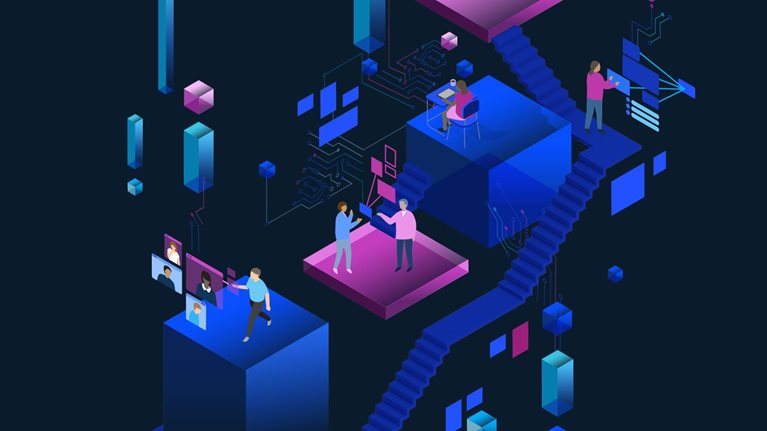Let’s say a retail merchandiser starts the process of analyzing scores of sales data and making recommendations for stock adjustments. Today, this worker is likely to perform that task using some amount of assistance from AI and automation tools, but not enough to meaningfully change the person’s day-to-day life. In the future, technologies such as gen AI, agents, predictive demand forecasting, and automated inventory management will be just a few of the tools that could help make retail merchandisers’ jobs more efficient. And that task, which today could take up to two or three weeks to complete, will more likely take as little as two to three hours (if not fewer) using these new tools.
Tech and automation are increasingly changing the way work gets done. How should consumer leaders reshape functions, roles, and activities in anticipation of this future state?
Many executives don’t have the answer to that question yet, and the time left to figure it out is dwindling. Technology first-movers are rapidly innovating and starting to build a competitive edge over their peers in terms of cost structure, employee effectiveness, and winning with the consumer. In fact, consumer-packaged-goods (CPG) and retail companies that lead in digital and AI are already showing three times greater total shareholder returns compared with their peers in the sector.1
We also know that by 2030 and beyond, the roles and functions in leading consumer organizations, as well as the skills and capabilities required of consumer talent, will look far different from today’s. Our new analysis forecasts the automation potential across five consumer subsectors, more than 2,000 activities, and 800 roles (see sidebar, “About the research”). By 2035, technology (ranging from basic automation to gen AI and beyond) could affect up to 55 percent2 of workers’ current activities, including those on the front line up through the C-suite.
Yet most consumer organizations are either overwhelmed by the volume of gen AI (and agentic AI) use cases or are too focused on near-term initiatives to make any meaningful progress. When it comes to adopting technology more comprehensively, consumer executives admit to us that “something has to be done,” but most have not laid the groundwork to get started.
In this article, we explore automation’s impact on the consumer sector and how consumer executives can think about reshaping the enterprise, reimagining activities within functions, and revamping their approach to talent to turn automation’s potential into reality. While the impetus for this transformation may be new technologies, people and culture are at the heart of it.
Automation’s impact on the consumer sector
Automation3 could disproportionately affect the consumer sector compared with other sectors, in part because of ever-rising consumer expectations of speed to market and personalization. Another factor is the sector’s large workforce, much of which is made up of frontline and commercial roles (such as in marketing, merchandising, and pricing) that are particularly exposed to automation’s impact.
We estimate that by 2030, about 30 to 35 percent of all current activities across consumer functions could be automated, helping to improve workers’ productivity while adding value to the organization. By 2035, automation’s impact across consumer subsectors could begin to diverge (Exhibit 1). CPG organizations could see the greatest impact from technology, given the potential for gen AI and other automation tools to optimize these companies’ manufacturing and supply chains. For restaurants, the automation of back-of-house operations could make this subsector ripe for tech advancements as well.

Other consumer subsectors, such as retail, may not realize as much tech-enabled improvement in the next five to ten years, in part because of their dispersed workforces. CPG companies, comparatively, have more concentrated labor pools at their manufacturing plants and warehouses, allowing tech-enabled process improvements to have more of an impact.
In places where labor costs are higher, such as in the United States, investments in workforce automation could pay off more quickly, while the opposite is true in places where labor costs are lower.

Organize to Value
Build your operating model with value at the core
Functions reshaped: Analyzing supply chain, corporate, and commercial units
Automation’s impact will vary across functions as well, depending on three factors: how manual or repetitive a job is, how centralized a function’s labor pools and processes are, and how mature and affordable the relevant technologies are.
For example, in five years, the manufacturing function of the average CPG business is likely to see higher degrees of automation (around 40 percent) compared with other functions (Exhibit 2). Manufacturing is uniquely well positioned for automation, since most of the current activities in this function—including assembly line operations, equipment monitoring, and analysis of operational data—are manual, repetitive, or both. Manufacturing jobs are often concentrated in fewer, larger locations, such as plants or warehouses, and do not have any customer-facing exposure. Manufacturing facilities are also already adopting full- or partial-automation technologies that are helping to address high turnover and, in some cases, to improve worker safety. Automation is also helping to reduce product quality variances.

Sales, on the other hand, is likely to see relatively low automation in the next five years (around 25 percent), given how much this function involves customer-facing activities. But salespeople in businesses ranging from mom-and-pop stores to retail chains can improve their productivity with tools such as digital ordering platforms, which can help streamline the ordering process for customers and reduce manual, time-consuming work for frontline sales staff. While sales-related roles will remain, the ways of working for all sales roles will likely change substantially.
Functions that are typically more centralized, such as HR, finance, or global business services, could see up to 35 percent of their work automated in the next five years. For that to happen, consumer players should consider adjusting their functional operating models (indeed, leading companies are already using gen AI and other technologies to do so).
For the HR function, for instance, some organizations may benefit from moving from a typical model—with HR split into business partnering, shared-services centers, and groups focused on specific topics such as learning and development—into a leaner model in which people scientists4 collaborate with employees from other functions on priority projects.
Activities reimagined: Breaking down automation potential
Current automation tools are enhancing the productivity of at least some part of nearly every role in a consumer business. But how much of each role is automatable? And which specific activities are best suited for automation? To answer those questions, consumer companies must conduct a bottom-up assessment of automation potential in all roles and activities across the enterprise.
In our analysis, we projected the automation potential of current activities that roles across the consumer organization perform, factoring in the required investments, labor costs, and other inputs. To better organize the analysis, we pinpointed “job families,” or groups of roles that perform a similar set of underlying activities, within different functions.
Within the marketing function, for example, “brand marketers” is one job family. We quantified the percentage of time brand marketers currently spend on each of their activities, which provided a baseline for how much their productivity could improve through automation.
We found that up to about 22 percent of a brand marketer’s current activities could be automated in the next five years: Developing marketing and brand strategies, for instance, could see a 10 percent productivity improvement, while monitoring campaign performance could see a 40 percent productivity improvement (Exhibit 3). By 2035, automation could help make more than 50 percent of a brand marketer’s current activities more efficient.

This doesn’t mean that all organizations will be able to automate half of their brand marketers’ work. Any technological solution also needs to be cost-effective for that organization and align with its growth and investment priorities. Leaders should be able to determine how long it will take for a new automation tool to pay for itself.
Additionally, automating work doesn’t guarantee cost savings. Investing in a tech tool requires updating the operating model to ensure that employees adopt the tool. Executives should also consider how much time savings to capture versus reallocate. The answer is not so simple. In some situations, for example, it is more beneficial to reallocate brand marketers’ time that is saved through automation tools to other, higher-value activities (Exhibit 4). This is where role-imagining comes into play: The most forward-thinking executives and people leaders will reshape roles and redesign activities, ensuring that employees spend most of their time on strategic, relationship-driven work that only humans can do, and less time on manual processing, recordkeeping, and more routine tasks.

Recalibrating team structures, workflows, capabilities, and culture
In the medium term, there might be a shortage of talent in critical new roles, such as product flow engineers, integrative-marketing strategists, and consumer experience designers, since fewer people will have the skills required to perform these roles. We expect this shortage to correct over time as the talent market recalibrates to fill these roles and organizations reskill and upskill their workforces.
To stymie the impact of these talent shortages in the near and medium term, consumer leaders can consider the following questions, which relate to team structures, workflows, and capabilities and culture:
- How should I structure my teams, especially as functions become leaner?
- What will roles look like when up to 70 percent of their associated activities could be automated?
- What skills will my organization need more of in the future?
- What skills will be attainable through upskilling, and what will we need to acquire by hiring external talent?
- How will my capability-building programs need to evolve to accommodate the new skills mix?
Mapping the costs of a tech-enabled future
To realize automation’s potential, consumer companies will need to make significant investments in people capabilities, change management, technology solutions, and data. Investments and costs can be classified in two ways. The first is by function (there are frontline-heavy, distributed functions; centralized commercial functions; and centralized corporate functions). The second is by expenditures, which encompass the following:
- Capital expenditures. These include hardware, network upgrades for physical plants and distribution centers, IT network capacity, and bandwidth upgrades.
- One-time operating expenditures. These include change management investments, upskilling or reskilling costs, and incremental depreciation. (Investments in change management are particularly critical, as they will be necessary to keep any changes in place over time.)
- Recurring operating expenditures. These include software licenses, new roles, and increases in average salaries driven by a shift toward higher-value skills.
For a typical CPG manufacturer, the first few years of automation implementation are likely to be cash-flow negative. This means the organization will need to rethink how to reallocate cash in areas including media investments, consumer promotions, and portfolio expansions while remaining committed to tech investments during the transition period, which could last up to five years in this scenario. Consumer chief human resources officers, chief technology officers, CFOs, and functional leaders should work together to create these projections.
How to turn automation’s potential into real value
The tech-enabled consumer enterprise will likely look and feel radically different. Its operations will be leaner, its output faster, and its labor pools higher skilled. Consumer leaders need to plan for this future state today.
First movers are already not only piloting gen AI and automation tools but also creating tech transformation road maps and reallocating their capital mix to sustain current operations (by maintaining back-office IT and managing any debt from technology, for example) while investing for the future (such as investing in agentic AI across marketing and personalization or supply chain automation). Investments in new technologies should evolve the consumer organization’s value proposition and create a competitive distance from its peers.
Consumer leaders can take the following five actions to help make their 2030 vision a reality:
-
Build an objective, bottom-up fact base. This involves building a granular view of the organization’s labor force, including all major roles and their activities, to identify what work can be automated by what technology. This will act as an objective, data-backed foundation to build a robust business case for each tech solution, and it can also help leaders prioritize subfunctions, domains, and use cases.
High-priority areas for CPGs and retailers are those that relieve cost pressures (such as those on commodities and costs-at-shelf) and those that enable growth with consumers (such as those that enhance speed to market and improve pricing and promotion calendars). This model can be updated and refreshed as tech implementation becomes more feasible, value is captured, and the costs of tech investments become clearer or decrease.
- Invest in data and technology infrastructure foundations. Consumer leaders need actionable, data-backed insights to chart their strategy and road maps. People and technology leaders should collect clean structured and unstructured data that is interoperable across all functions. Tech infrastructure that is scalable, secure, and can be integrated with new technology is also required.
-
Define the organization’s new strategy-driven structure and frictionless workflows. To create stronger teams, leaders should define the organization’s new structure, redesign workflows, and determine the capabilities these teams should have.
The change in how a consumer business works will require employees to acquire new skills. Employees with these new skill sets will be in high demand, while other current employees may not be prepared for this future. For consumer players, speed to market will become more important, which means individuals who can translate business needs—including faster consumer insight generation and rapid product testing—into technical processes will become valuable employees.
Consumer companies should develop innovative methods for creating top talent, which could include reskilling efforts, academies developed in partnership with top universities, or other novel partnerships that create apprenticeship-like opportunities.
- Create a cross-functional team to steer the transformation. Companies should task a cross-functional group of leaders from the HR, technology, and finance functions (at the very least) to transform functions and the organization’s operating model. These leaders’ qualifications should include an understanding of the organization’s strategy and business units’ starting points, a strong tech background to implement the road map, and the credibility to influence other teams. This group will create and manage road maps, mobilize the organization, and track progress to ensure that the organization meets its milestones.
- Overinvest in change management to build the right capabilities and culture. Launch a focused upskilling and reskilling program to equip employees with the capabilities needed for the future. Provide targeted coaching to help employees shift their mindsets and better understand how their contributions drive impact.
Technologies poised to reshape the way consumer organizations work are on the horizon—some are already here—and consumer executives have a narrow window in which to respond. The challenge before them is complex: In this new era of collaboration between humans and technology, a successful transformation means not only learning new tools and skills but also redesigning work altogether. Even so, leaders should imagine the art of the possible rather than focusing on the roadblocks ahead. Those who do will be best positioned to create a tech-enabled enterprise with workers who can thrive, both now and into the future.


